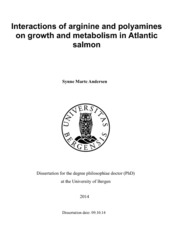| dc.contributor.author | Andersen, Synne Marte | eng |
| dc.date.accessioned | 2014-10-20T09:11:18Z | |
| dc.date.available | 2014-10-20T09:11:18Z | |
| dc.date.issued | 2014-10-09 | eng |
| dc.identifier.isbn | 978-82-308-2823-6 | en_US |
| dc.identifier.uri | http://hdl.handle.net/1956/8651 | |
| dc.description.abstract | Arginine and methionine are indispensable amino acids (AA) for Atlantic salmon, meaning that salmon is unable to produce these AA endogenously and is fully dependent on dietary supply. In addition to be substrates for protein synthesis, these AA are involved in several metabolic pathways in the fish. Arginine is used for production of nitric oxide, creatine, urea and polyamines, while methionine is converted to the methyl donor S-adenosyl methionine (SAM), which is important for polyamine production by supplying the aminopropyl donor decarboxylated SAM. Thus, both arginine and methionine may influence polyamine production. Polyamines are essential for cell growth and differentiation and can modulate gene expression and energy metabolism, stabilize proteins and cell membranes. Polyamines can also induce apoptosis and formation of reactive oxygen species under too high concentrations. Dietary arginine supplementation have been demonstrated to reduce visceral mass while increasing lean mass in pigs and rodents, which has been linked to increased energy consumption caused by increased polyamine production. Hence we aimed to investigate whether arginine supplementation to Atlantic salmon could affect growth and deposition pattern, and to what extent any effects was linked to increased production and catabolism of polyamines. We also assessed if methionine affected polyamine production by modulating SAM availability. Two feeding trials were conducted, in juvenile and adult Atlantic salmon, with graded supplementation of arginine beyond the established requirement for growth. Tissue samples were taken to analyse gene expression, amino acids, polyamines and other metabolic parameters. Liver cells were isolated from the adult salmon fed graded inclusions of arginine and cultured in vitro together with activator/inhibitor of polyamine metabolism, in order to assess the importance of polyamine metabolism for cell survival and lipid metabolism. Metabolomic analysis applying HPLC-QTOF MS were performed on liver and plasma samples from the adult salmon to assess how arginine affects metabolic pathways. At last, a feeding trial were performed using 5 juvenile salmon fed a methionine deficient diet or a diet with methionine just above requirement to assess the impact on polyamine metabolism and turnover. In juvenile salmon fed increasing arginine an effect on growth was observed, but this effect was not linear. The growth was due to an effect on both protein and lipid deposition, appeared to be equally distributed between tissues and was likely due to a faster overall growth. In adult salmon arginine had no effect on growth or deposition of fat or protein. Juvenile salmon appeared to have increased turnover of polyamines in the liver and this was associated with increased expression of carnitine palmitoyl transferase-1 (CPT-1), that increased oxidation of long-chained fatty acids in the liver. Arginine did not affect polyamine concentrations in adult salmon, and we could not document a clear effect on energy metabolism or growth. Metabolomic investigation of plasma and liver however, showed that arginine affected metabolism, even if no growth differences were observed. This revealed novel interactions of arginine in the metabolism of Atlantic salmon, such as interactions with heme, vitamin D, prostaglandins and branched chain AA. These interactions warrants further exploration. Cell studies on the isolated liver cells further confirmed that arginine significantly affected the metabolome and indicated an involvement of arginine in glucose metabolism. The cell studies also showed a difference in the initial and longterm responses to arginine in liver cells, suggesting an adaptation to long-term arginine supplementation. Also, arginine appeared to affect metabolism and cell survival trough pathways independent of polyamines. Finally, the methionine trial demonstrated that methionine deficiency strongly affects tissue concentrations of polyamines and SAM, suggesting that methionine is crucial to maintain polyamine homeostasis and thus avoid cell damage in liver of Atlantic salmon. | en_US |
| dc.language.iso | eng | eng |
| dc.publisher | The University of Bergen | en_US |
| dc.relation.haspart | Paper I: Andersen, S.M., Holen, E., Aksnes, A., Rønnestad, I., Zerrahn, J.E. and Espe, M. (2013). "Dietary arginine affects energy metabolism through polyamine turnover in juvenile Atlantic salmon (Salmo salar)." British Journal of Nutrition 110, 1968-1977. Full text not available in BORA due to publisher restrictions. The article is available at: <a href="http://dx.doi.org/10.1017/S0007114513001402" target="blank">http://dx.doi.org/10.1017/S0007114513001402</a>. | en_US |
| dc.relation.haspart | Paper II: Andersen, S.M., Holen, E., Aksnes, A., Rønnestad, I., Zerrahn, J.E. and Espe, M. (2014). ”Adult Atlantic salmon (Salmo salar L.) adapts to long-term surplus dietary arginine supplementation.” Aquaculture Nutrition. Full text not available in BORA due to publisher restrictions. The article is available at: <a href="http://dx.doi.org/10.1111/anu.12168" target="blank">http://dx.doi.org/10.1111/anu.12168</a>. | en_US |
| dc.relation.haspart | Paper III: Andersen, S.M., Taylor, R., Holen, E., Aksnes, A. and Espe, M. (2014). “Arginine concentration and exposure time affects polyamine and glucose metabolism in primary liver cells isolated from Atlantic salmon.” Amino Acids 46, 1225-1233. Full text not available in BORA due to publisher restrictions. The article is available at: <a href="http://dx.doi.org/10.1007/s00726-014-1684-4" target="blank">http://dx.doi.org/10.1007/s00726-014-1684-4</a>. | en_US |
| dc.relation.haspart | Paper IV: Andersen, S.M., Assaad, H.I., Lin, G., Wang, J., Aksnes, A., Wu, G. and Espe, M. (2014). ”Metabolomic analysis of plasma and liver from surplus arginine fed Atlantic salmon.” Frontiers in Bioscience. Full text not available in BORA. | en_US |
| dc.relation.haspart | Paper V: Espe, M., Andersen, S.M., Holen, E., Rønnestad, I., Veiseth-Kent, E., Zerrahn, J.E. and Aksnes, A. (2014). ” Methionine deficiency does not increase polyamine turnover through depletion of liver S-adenosylmethionine (SAM) in juvenile Atlantic salmon.” British Journal of Nutrition. Full text not available in BORA due to publisher restrictions. The article is available at: <a href="http://dx.doi.org/10.1017/S0007114514002062" target="blank">http://dx.doi.org/10.1017/S0007114514002062</a>. | en_US |
| dc.title | Interactions of arginine and polyamines on growth and metabolism in Atlantic salmon | en_US |
| dc.type | Doctoral thesis | |
| dc.rights.holder | Copyright the author. All rights reserved | en_US |
